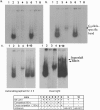Functional variants in the promoter region of Chitinase 3-like 1 (CHI3L1) and susceptibility to schizophrenia
- PMID: 17160890
- PMCID: PMC1785314
- DOI: 10.1086/510438
Functional variants in the promoter region of Chitinase 3-like 1 (CHI3L1) and susceptibility to schizophrenia
Abstract
The chitinase 3-like 1 gene (CHI3L1) is abnormally expressed in the hippocampus of subjects with schizophrenia and may be involved in the cellular response to various environmental events that are reported to increase the risk of schizophrenia. Here, we provide evidence that the functional variants at the CHI3L1 locus influence the genetic risk of schizophrenia. First, using case-control and transmission/disequilibrium-test (TDT) methodologies, we detected a significant association between schizophrenia and haplotypes within the promoter region of CHI3L1 in two independent cohorts of Chinese individuals. Second, the at-risk CCC haplotype (P=.00058 and .0018 in case-control and TDT studies, respectively) revealed lower transcriptional activity (P=2.2 x 10(-7)) and was associated with lower expression (P=3.1 x 10(-5)) compared with neutral and protective haplotypes. Third, we found that an allele of SNP4 (rs4950928), the tagging SNP of CCC, impaired the MYC/MAX-regulated transcriptional activation of CHI3L1 by altering the transcriptional-factor consensus sequences, and this may be responsible for the decreased expression of the CCC haplotype. In contrast, the protective TTG haplotype was associated with a high level of CHI3L1 expression. Our findings identify CHI3L1 as a potential schizophrenia-susceptibility gene and suggest that the genes involved in the biological response to adverse environmental conditions are likely to play roles in the predisposition to schizophrenia.
Figures






Similar articles
-
The chitinase 3-like 1 gene and schizophrenia: evidence from a multi-center case-control study and meta-analysis.Schizophr Res. 2010 Feb;116(2-3):126-32. doi: 10.1016/j.schres.2009.12.002. Epub 2010 Jan 3. Schizophr Res. 2010. PMID: 20051317
-
Chitinase-3-like 1 (CHI3L1) gene and schizophrenia: genetic association and a potential functional mechanism.Biol Psychiatry. 2008 Jul 15;64(2):98-103. doi: 10.1016/j.biopsych.2007.12.012. Epub 2008 Feb 20. Biol Psychiatry. 2008. PMID: 18281018
-
Failure to confirm genetic association of the CHI3L1 gene with schizophrenia in Japanese and Chinese populations.Am J Med Genet B Neuropsychiatr Genet. 2009 Jun 5;150B(4):508-14. doi: 10.1002/ajmg.b.30847. Am J Med Genet B Neuropsychiatr Genet. 2009. PMID: 18767121
-
The chitinase and chitinase-like proteins: a review of genetic and functional studies in asthma and immune-mediated diseases.Curr Opin Allergy Clin Immunol. 2009 Oct;9(5):401-8. doi: 10.1097/ACI.0b013e3283306533. Curr Opin Allergy Clin Immunol. 2009. PMID: 19644363 Free PMC article. Review.
-
Chitinase 3-Like-1 (CHI3L1): a putative disease marker at the interface of proteomics and glycomics.Crit Rev Clin Lab Sci. 2008;45(6):531-62. doi: 10.1080/10408360802334743. Crit Rev Clin Lab Sci. 2008. PMID: 19003601 Review.
Cited by
-
Detailed Functional Characterization of a Waist-Hip Ratio Locus in 7p15.2 Defines an Enhancer Controlling Adipocyte Differentiation.iScience. 2019 Oct 25;20:42-59. doi: 10.1016/j.isci.2019.09.006. Epub 2019 Sep 10. iScience. 2019. PMID: 31557715 Free PMC article.
-
Molecular differentiation of schizoaffective disorder from schizophrenia using BDNF haplotypes.Br J Psychiatry. 2009 Apr;194(4):313-8. doi: 10.1192/bjp.bp.108.050401. Br J Psychiatry. 2009. PMID: 19336781 Free PMC article.
-
Significance of chitinase-3-like protein 1 in the pathogenesis of inflammatory diseases and cancer.Exp Mol Med. 2024 Feb;56(1):1-18. doi: 10.1038/s12276-023-01131-9. Epub 2024 Jan 4. Exp Mol Med. 2024. PMID: 38177294 Free PMC article. Review.
-
YKL-40-A Protein in the Field of Translational Medicine: A Role as a Biomarker in Cancer Patients?Cancers (Basel). 2010 Jul 12;2(3):1453-91. doi: 10.3390/cancers2031453. Cancers (Basel). 2010. PMID: 24281168 Free PMC article.
-
Are SMAD7 rs4939827 and CHI3L1 rs4950928 polymorphisms associated with colorectal cancer in Egyptian patients?Tumour Biol. 2016 Jul;37(7):9387-97. doi: 10.1007/s13277-016-4813-8. Epub 2016 Jan 16. Tumour Biol. 2016. PMID: 26779637
References
Web Resources
-
- dbSNP, http://www.ncbi.nlm.nih.gov/SNP/ (for SNP1–SNP5)
-
- Online Mendelian Inheritance in Man (OMIM), http://www.ncbi.nlm.nih.gov/Omim/ (for schizophrenia and CHI3L1)
References
Publication types
MeSH terms
Substances
LinkOut - more resources
Full Text Sources
Other Literature Sources
Medical
Molecular Biology Databases

